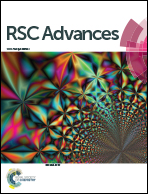Synthesis and organic field effect transistor properties of isoindigo/DPP-based polymers containing a thermolabile group†
Abstract
(E)-6,6′-Dibromo-1,1-bis(2-octyldodecyl)-(3,3′-biindolinylid-ene)-2,2′-dione and/or 2,5-bis(2-octyldodecyl)-3,6-di(5-bromothien-2-yl)pyrrolo[3,4-c]pyrrole-1,4-(2H,5H)-dione and their tBoc-counterparts were propagated with 2,5-bis(tributylstannyl)thiophene in a molar ratio of 0.8 : 0.2 : 1.0 to release P(ODIDT-BID), P(ODIDT·BDPP), P(ODDPPT·BID) and P(ODDPPT·BDPP) as a new series of random conjugated polymers (RCPs) bearing a large number of octyldodecyl chains to ensure solubility and a small number of thermocleavable tBoc function to cast H-bonding upon heating up to 220 °C. All new polymers were synthesised via Pd catalysed Stille cross-coupling methodology in high yields and reasonable average molecular weights. The cast polymer films exhibited considerable red-shifted UV-vis absorption spectra and a further red-shift was also obtained in the thermal annealed films (at 220 °C for 30 min), which reflected the increasing of crystalline structure. The formation of H-bonding in these polymers was investigated using X-ray diffractometry (XRD) measurements. The field-effect mobilities of these polymers were investigated in the configuration of bottom-gate and bottom-contact (BGBC) field-effect transistors (FETs). The results from FETs indicated that the crystalline structure of RCPs exhibited reasonable FET mobilities with 1.17 × 10−3 cm2 V−1 s−1 for P(ODDPPT·BID) and 1.41 × 10−3 cm2 V−1 s−1 for P(ODDPPT·BDPP).



 Please wait while we load your content...
Please wait while we load your content...